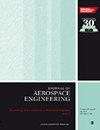Blade tip leakage flow and heat transfer characteristics over a gas turbine blade at subsonic and transonic exit conditions
IF 1.1
4区 工程技术
Q3 ENGINEERING, AEROSPACE
Proceedings of the Institution of Mechanical Engineers Part G-Journal of Aerospace Engineering
Pub Date : 2023-10-23
DOI:10.1177/09544100231205671
引用次数: 0
Abstract
The present study numerically investigates the blade tip leakage flow (TLF) over a gas turbine blade cascade at low speed ( M ex = 0.1) and transonic ( M ex = 0.92) blade exit Mach numbers, with and without shroud motion. Various blade tip flow phenomena like flow separation and reattachment, flow choking, shock-boundary layer interaction (SBLI), and tip leakage vortex (TLV) are studied, and their influence on the heat transfer coefficient (HTC) distributions over the blade tip and near tip blade suction surface is investigated. The study has found some new zones of heat transfer due to the interaction of horseshoe vortices (HSV) with the blade tip. In addition to the primary TLV, a secondary TLV is formed, which increases near tip blade suction surface heat transfer. The flow transitions to supersonic speed in the aft portion of the blade tip for the transonic case resulting in complex heat transfer distribution due to SBLI, compared to near-uniform distribution for the low speed case. This supersonic flow results in a smaller flow separation zone near the aft portion of the pressure side tip edge for the transonic case compared to the low speed case. The qualitative nature of HTC near the leading edge of the blade tip resembles for low speed and transonic cases. However, near the trailing edge of the blade tip, the qualitative nature of HTC for the transonic case shows a substantial difference due to supersonic flow compared to the low speed case.燃气轮机叶片在亚声速和跨声速出口条件下叶尖泄漏流动和传热特性
本文对燃气轮机叶片叶栅低速(mex = 0.1)和跨声速(mex = 0.92)叶片出口马赫数下叶尖泄漏流动(TLF)进行了数值研究。研究了不同的叶尖流动现象,如流动分离与再附着、流动阻塞、激波-边界层相互作用(SBLI)和叶尖泄漏涡(TLV),以及它们对叶尖和近叶尖吸力面传热系数(HTC)分布的影响。研究发现,由于马蹄涡与叶尖的相互作用,出现了一些新的换热区。在主TLV的基础上,形成了二次TLV,增加了近叶尖吸力表面的换热。在跨音速情况下,流动在叶尖尾部过渡到超音速,由于SBLI,与低速情况下接近均匀的传热分布相比,传热分布复杂。与低速情况相比,这种超声速流动导致在跨声速情况下,靠近压力侧尖端边缘尾部的流动分离区更小。在叶片尖端前缘附近的HTC的定性性质类似于低速和跨音速的情况。然而,在叶尖后缘附近,由于超声速流动与低速情况相比,跨声速情况下HTC的定性性质显示出实质性的差异。
本文章由计算机程序翻译,如有差异,请以英文原文为准。
求助全文
约1分钟内获得全文
求助全文
来源期刊

CiteScore
2.40
自引率
18.20%
发文量
212
审稿时长
5.7 months
期刊介绍:
The Journal of Aerospace Engineering is dedicated to the publication of high quality research in all branches of applied sciences and technology dealing with aircraft and spacecraft, and their support systems. "Our authorship is truly international and all efforts are made to ensure that each paper is presented in the best possible way and reaches a wide audience.
"The Editorial Board is composed of recognized experts representing the technical communities of fifteen countries. The Board Members work in close cooperation with the editors, reviewers, and authors to achieve a consistent standard of well written and presented papers."Professor Rodrigo Martinez-Val, Universidad Politécnica de Madrid, Spain
This journal is a member of the Committee on Publication Ethics (COPE).
 求助内容:
求助内容: 应助结果提醒方式:
应助结果提醒方式:


